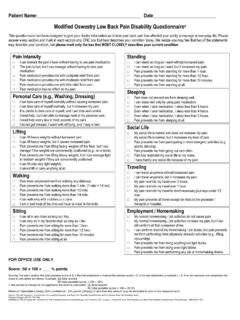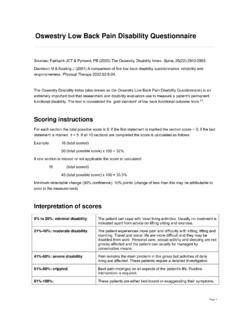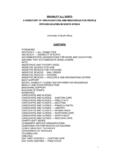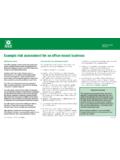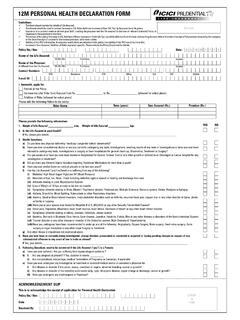Transcription of 6.24 Low back pain - World Health Organization
1 6. Priority diseases and reasons for inclusion 1 Low back pain See Background Paper ( ) Background Low back pain is a very common Health problem worldwide and a major cause of disability - affecting performance at work and general well-being. Low back pain can be acute, sub-acute, or chronic. Though several risk factors have been identified (including occupational posture, depressive moods, obesity, body height and age), the causes of the onset of low back pain remain obscure and diagnosis difficult to make. back pain is not a disease but a constellation of symptoms. In most cases, the origins remain unknown. Low back pain affects people of all ages, from children to the elderly, and is a very frequent reason for medical consultations. The 2010 Global Burden of Disease Study estimated that low back pain is among the top 10 diseases and injuries that account for the highest number of DALYs It is difficult to estimate the incidence of low back pain as the incidence of first-ever episodes of low back pain is already high by early adulthood and symptoms tend to recur over time.
2 The lifetime prevalence of non-specific (common) low back pain is estimated at 60% to 70% in industrialized countries (one-year prevalence 15% to 45%, adult incidence 5% per year). The prevalence rate for children and adolescents is lower than that seen in adults but is ,3 Prevalence increases and peaks between the ages of 35 and As the World population ages, low back pain will increase substantially due to the deterioration of the intervertebral discs in older people. Low back pain is the leading cause of activity limitation and work absence throughout much of the World , imposing a high economic burden on individuals, families, communities, industry, and ,4 Several studies have been performed in Europe to evaluate the social and economic impact of low back pain .
3 In the United Kingdom, low back pain was identified as the most common cause of disability in young adults, with more than 100 million workdays lost per In Sweden, a survey suggested that low back pain accounted for a quadrupling of the number of work days lost from 7 million in 1980 to 28 million by 1987. However, the authors state that the existence of social compensation systems in Sweden might account for some of this In the United States, an estimated 149 million work days are lost every year because of low back pain ,6 with total costs estimated to be US$ 100 to 200 billion a year (of which two-thirds is due to lost wages and lower productivity).7,8 At present low back pain is treated mainly with analgesics. The causes of lower back pain are rarely addressed.
4 Alternative treatments include physical therapy, rehabilitation and spinal manipulation. Disc surgery remains the last option when all other strategies have failed, but the outcomes are Priority Medicines for Europe and the World 2013 Update 2 Figure : Absolute DALYs caused by low back pain by age group and European region Source: Institute of Health Metrics and Evaluation (IHME) Developments since 2004 European guidelines for the management of chronic non-specific low back pain have been developed by experts in the field and provide guidance for diagnosis and treatment. The European Commission is also funding the project Genodisc to identify risks factors, biomarkers, and improve diagnosis of low back Research performed over recent years on biomaterials, growth factors or stem cells in the intra-vertebral disc space brings new hope for delaying the time before surgery is required.
5 The development of 3-dimensional imaging and more resistant biomaterials should help in addressing the issue of disc prosthesis for low back pain . Research needs Future areas for public sector research include: the establishment of biomarkers the search for anthropometric risk factors and adapted rehabilitation the development of biomaterials for disc replacement therapies stem cell research to restore discs and the intervertebral space. 0100,000200,000300,000400,000500,000600, 000700,000800,000900,0001,000,000 Absolute DALYs Age groups Central EuropeEastern EuropeWestern Europe6. Priority diseases and reasons for inclusion 3 There is a still long way to go to improve diagnosis and identify other potential risk factors. As the World population ages, the disease burden of low back pain will increase substantially.
6 If surgery and disc replacement therapies are currently the last option to relieve back pain when all other strategies have failed, new developments in 3D imaging, biomaterials and disc renutrition or stem cell therapies may bring new hope for the treatment of low back pain . References 1 Years lived with disability (YLDs) for 1160 sequelae of 289 diseases and injuries 1990-2010: a systematic analysis for the Global Burden of Disease Study 2010. Lancet, 2012, 380(9859):2163-96. doi: (12)61729-2. Erratum in: Lancet, 2013, 381(9867):628. Al Mazroa, Mohammad A. 2 Taimela S, Kujala UM, Salminen JJ & Viljanen T. The prevalence of low back pain among children and adolescents: a nationwide, cohort-based questionnaire survey in Finland. Spine, 1997, 22: 1132 1136. 3 Balague F, Troussier B & Salminen JJ. Non-specific low back pain in children and adolescents: risk factors.
7 Eur Spine J, 1999, 8: 429 438. 4 Andersson GBJ. The Epidemiology of Spinal Disorders. In Frymoyer JW (ed.) The Adult Spine: Principles and Practice. Philadelphia, Lippincott-Raven, 1997, pp. 93 141. 5 Croft P et al. The prevalence and characteristics of chronic widespread pain in the general population. Journal of Rheumatology, 1993, 20:710-3. 6 Guo HR, Tanaka S, Halperin WE, Cameron LL. back pain prevalence in US industry and estimates of lost workdays. Am J Public Health , 1999, 89(7):1029-1035. 7 Katz JN. Lumbar disc disorders and low- back pain : socioeconomic factors and consequences. J Bone Joint Surg Am, 2006, 88(suppl 2):21-24. 8 Rubin DI. Epidemiology and risk factors for spine pain . Neurol Clin, 2007, 25(2):353-371. 9 Phillips FM, Slosar PJ, Youssef JA, Andersson G. Lumbar Spine Fusion for Chronic Low back pain due to Degenerative Disc Disease: A Systematic Review.
8 Spine, 2013, (Phila Pa 1976). 10 Educell website. Last accessed March 2013.










